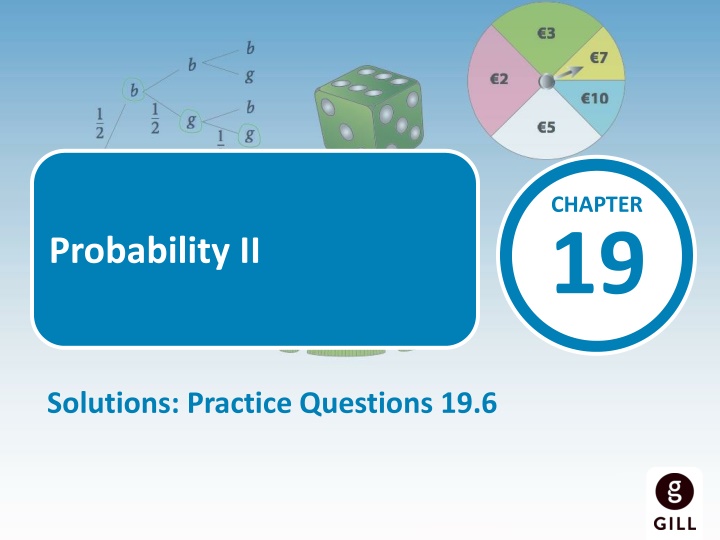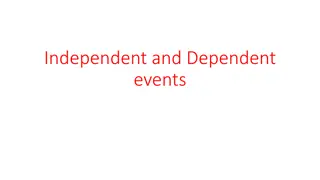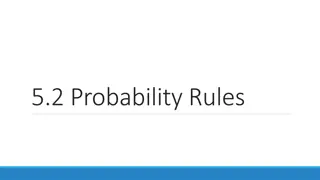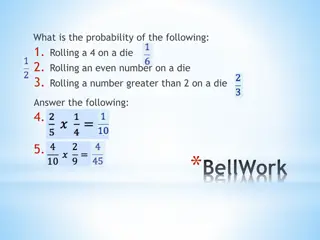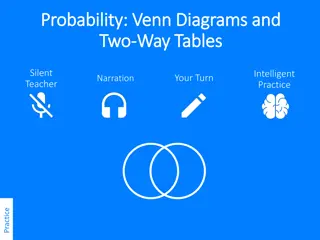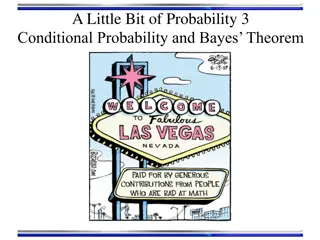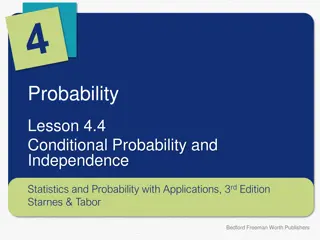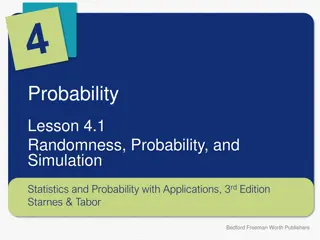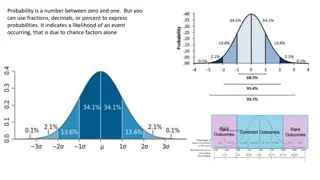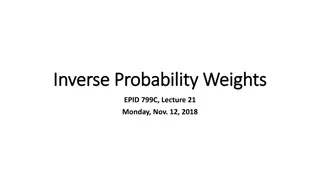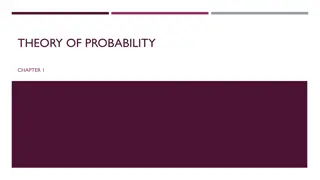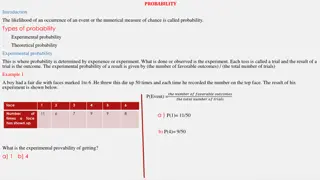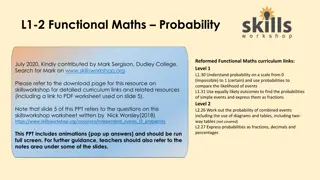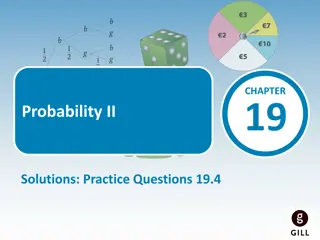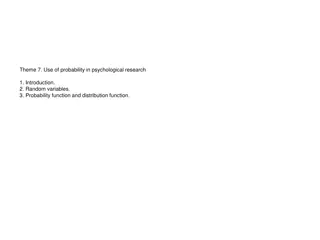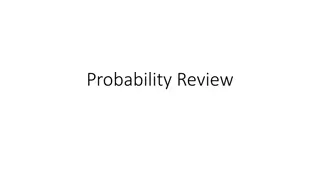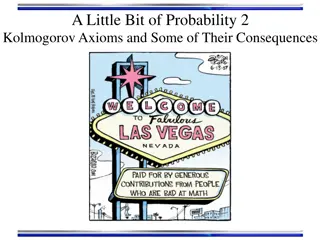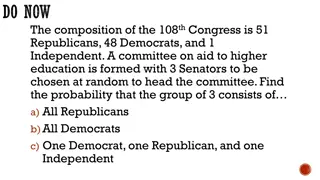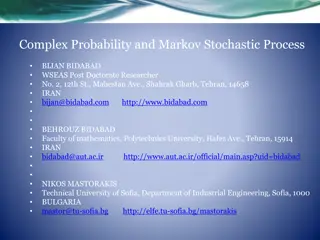Probability Practice Questions and Solutions
Solve probability practice questions involving saving penalties, defective items, dice rolls, and voting intentions in a local electorate. Understand how to calculate expected outcomes and probabilities based on given data.
Download Presentation

Please find below an Image/Link to download the presentation.
The content on the website is provided AS IS for your information and personal use only. It may not be sold, licensed, or shared on other websites without obtaining consent from the author.If you encounter any issues during the download, it is possible that the publisher has removed the file from their server.
You are allowed to download the files provided on this website for personal or commercial use, subject to the condition that they are used lawfully. All files are the property of their respective owners.
The content on the website is provided AS IS for your information and personal use only. It may not be sold, licensed, or shared on other websites without obtaining consent from the author.
E N D
Presentation Transcript
CHAPTER 19 Probability II Solutions: Practice Questions 19.6
19 Practice Questions 19.6 3 5 1. A goalkeeper has a probability of of saving a penalty. How many penalties would you expect him to save out of 50 penalties taken? 3 5 ( ) = = P Save 50 Penalties n = p n Expected 3 5 = 50 = 30 He would be expected to save 30 penalties.
19 Practice Questions 19.6 2. A batch of 1,600 items is examined. The probability that an item from this batch is defective is 0 04. How many items from this batch are defective? P(Defective) = 0 04 1600 items = n Expected = p n = 0 04 1600 = 64 Expect 64 items to be defective.
19 Practice Questions 19.6 3. In an experiment, a standard six-sided die was rolled 72 times. The results are shown in the table. Which number on the die was obtained the expected number of times? Number on the die Frequency 1 11 2 8 3 4 5 6 12 15 16 10 1 6 ( ) = = P Any number on a die 72 rolls n = p n Expected 1 6 12 = 72 = Therefore, 3 was rolled the expected number of times.
19 Practice Questions 19.6 4. In a random survey of the voting intentions of a local electorate, the following results were obtained: Politician A 165 Politician B 87 Politician C 48 Calculate the probability that a randomly selected voter will vote for: (i) (a) Politician A Total votes = 165 + 87 + 48 = 300 165 300 11 20 ( ) P A = =
19 Practice Questions 19.6 4. In a random survey of the voting intentions of a local electorate, the following results were obtained: Politician A 165 Politician B 87 Politician C 48 Calculate the probability that a randomly selected voter will vote for: (i) (b) Politician B 87 300 29 100 ( ) P B = =
19 Practice Questions 19.6 4. In a random survey of the voting intentions of a local electorate, the following results were obtained: Politician A 165 Politician B 87 Politician C 48 Calculate the probability that a randomly selected voter will vote for: (i) (c) Politician C P(C)=48 300 =4 25
19 Practice Questions 19.6 4. In a random survey of the voting intentions of a local electorate, the following results were obtained: Politician A 165 Politician B 87 Politician C 48 (a) Politician A? If there are 7,500 people in the electorate, how many votes would you expect to be for: (ii) 11 20 = Expected 7,500 7,500 people = n = 4,125 Expected = p n
19 Practice Questions 19.6 4. In a random survey of the voting intentions of a local electorate, the following results were obtained: Politician A 165 Politician B 87 Politician C 48 (b) Politician B? If there are 7,500 people in the electorate, how many votes would you expect to be for: (ii) 29 100 = Expected 7,500 7,500 people = n = 2,175 Expected = p n
19 Practice Questions 19.6 4. In a random survey of the voting intentions of a local electorate, the following results were obtained: Politician A 165 Politician B 87 Politician C 48 (c) Politician C? If there are 7,500 people in the electorate, how many votes would you expect to be for: (ii) 4 25 = Expected 7,500 7,500 people = n = 1,200 Expected = p n
19 Practice Questions 19.6 5. In a raffle, 250 tickets are sold at 1 each for three prizes of 100, 50 and 10. You buy one ticket. 2 5 16 25 0 64 = 1 5 1 25 ( ) What is the expected value of this raffle? (i) x p x = + + + . 0 Expected value: x.p(x) =
19 Practice Questions 19.6 5. In a raffle, 250 tickets are sold at 1 each for three prizes of 100, 50 and 10. You buy one ticket. Does it represent a good investment of 1? (ii) Explain your answer. It does not represent a good investment of 1 as the expected value is 0 64 which means if a large number of people bought tickets the average win is below the pay in amount. You would expect to lose 0 36. Net winnings = 0 64 1 = 0 36
19 Practice Questions 19.6 6. Jennifer is playing a game at an amusement park. There is a 0 1 probability that she will score 10 points, a 0 2 probability that she will score 20 points, and a 0 7 probability that she will score 30 points. How many points can Jennifer expect to receive by playing the game? Expected value = x.p(x) p(x) 0 1 0 2 0 7 x.p(x) x 10 0 1 = 1 20 0 2 = 4 30 0 7 = 21 10 20 30 x.p(x) = 1 + 4 + 21 = 26 points
19 Practice Questions 19.6 7. You take out a fire insurance policy on your home. The annual premium is 300. In case of fire, the insurance company will pay you 200,000. The probability of a house fire in your area is 0 0002. What is the expected value? (i) p(x) 0 0002 x.p(x) X 200,000 0 0002 = 40 0 0 9998 = 0 Fire 200,000 No Fire 0 [1 0 002] 0 9998 Expected value = x p(x) = 40 + 0 = 40
19 Practice Questions 19.6 7. You take out a fire insurance policy on your home. The annual premium is 300. On case of fire, the insurance company will pay you 200,000. The probability of a house fire in your area is 0 0002. p(x) 0 0002 x.p(x) X 200,000 0 0002 = 40 0 0 9998 = 0 Fire 200,000 No Fire 0 [1 0 002] 0 9998 What is the insurance company s expected value? (ii) The expected value is the same for the insurance company and customer. However, the perspective is changed. The customer is down 260 since they paid 300 for the policy, the company is up 260.
19 Practice Questions 19.6 7. You take out a fire insurance policy on your home. The annual premium is 300. On case of fire, the insurance company will pay you 200,000. The probability of a house fire in your area is 0 0002. p(x) 0 0002 x.p(x) X 200,000 0 0002 = 40 0 0 9998 = 0 Fire 200,000 No Fire 0 [1 0 002] 0 9998 Suppose the insurance company sells 100,000 of these policies. What can the company expect to earn? (iii) Profit on 1 policy: = 260 100,000 policies : 100,000 260 = 26,000,000
19 Practice Questions 19.6 8. A hundred tickets are sold for a movie at the cost of 10 each. Some tickets have cash prizes as a part of a promotional campaign: one prize of 50, three prizes of 25 and five prizes of 20. What is the expected value if you buy one ticket? Expected value: x.p(x) 1 2 9 4 3 4 ( ) x p x = + 1 0 + + . p(x) x.p(x) x 50 1 1 1 2 = = 50 100 100 2 25 = 3 3 4 25 3 = 25 100 100 20 5 5 = 20 1 100 100 0 91 100 91 100 = 0 0
19 Practice Questions 19.6 9. You pay 10 to play the following game of chance. There is a bag containing 12 balls, five are red, three are green and the rest are yellow. You are to draw one ball from the bag. You will win 14 if you draw a red ball and you will win 12 if you draw a green ball. How much do you expect to win or lose if you play this game 100 times? Outcome Red x Pay Out 14 p(x) 5 12 3 12 4 12 x.p(x) 5 12 35 6 ( ) x p x = 3 0 + + . 35 6 = 14 53 6 = 3 Green 12 = 12 3 12 8 83 = Yellow 0 4 = 0 0 12
19 Practice Questions 19.6 9. You pay 10 to play the following game of chance. There is a bag containing 12 balls, five are red, three are green and the rest are yellow. You are to draw one ball from the bag. You will win 14 if you draw a red ball and you will win 12 if you draw a green ball. How much do you expect to win or lose if you play this game 100 times? Pay 10 Expected value 8 83 so nett winnings = 8 83 10 = 7 6 1 167 100 = 100 games 350 3 = = = 116 67 nett loss
19 Practice Questions 19.6 10. A sports club decides to hold a field day to raise money for local charities. One of the games involves spinning the wheel shown on the right. You win the amount the pointer lands on. It costs 5 to play the game. What is the expected value of the game? (i) 3 4 7 8 5 4 5 4 1 2 ( ) x p x = + + + + . Expected value = x p(x) 37 8 = 4 625 = 4 63 is the expected value of the game.
19 Practice Questions 19.6 10. A sports club decides to hold a field day to raise money for local charities. One of the games involves spinning the wheel shown on the right. You win the amount the pointer lands on. It costs 5 to play the game. How could they adjust the wheel to ensure they make more money for the charities? (ii) In order to make more money for the charities they could lower the amount that is won in each or some segment(s). Or They could enlarge the 2 segment and make the 5 segment smaller.
19 Practice Questions 19.6 11. A child asks his parents for some money. The parents make the following offers. Which offer has the greater expected value? (i) Expected value = x.p(x) Father s offer Father s offer: The child flips a coin. If the coin lands heads-up, the father will give the child 20. If the coin lands tails-up, the father will give the child nothing. Mother s offer: The child rolls a 6-sided die. The mother will give the child 3 for each dot on the up side of the die. x.p(x) = 10
19 Practice Questions 19.6 11. A child asks his parents for some money. The parents make the following offers. Which offer has the greater expected value? (i) Mother s offer Father s offer: The child flips a coin. If the coin lands heads-up, the father will give the child 20. If the coin lands tails-up, the father will give the child nothing. Mother s offer: The child rolls a 6-sided die. The mother will give the child 3 for each dot on the up side of the die.
19 Practice Questions 19.6 11. A child asks his parents for some money. The parents make the following offers. Which offer has the greater expected value? (i) Mother s offer 1 2 21 2 3 2 5 2 ( ) Father s offer: The child flips a coin. If the coin lands heads-up, the father will give the child 20. If the coin lands tails-up, the father will give the child nothing. x p x = + + + + + . 1 2 3 = = 10 5 Mother s offer: The child rolls a 6-sided die. The mother will give the child 3 for each dot on the up side of the die. 10 50 > 10 Therefore, the mother s offer is greater.
19 Practice Questions 19.6 11. A child asks his parents for some money. The parents make the following offers. Which offer would you choose if you were the child? Justify your answer. (ii) I would choose the mother s offer as over many times the expected outcome would be higher. Father s offer: The child flips a coin. If the coin lands heads-up, the father will give the child 20. If the coin lands tails-up, the father will give the child nothing. Mother s offer: The child rolls a 6-sided die. The mother will give the child 3 for each dot on the up side of the die.
19 Practice Questions 19.6 12. (i) What is the expected value for each of the following investment packages for a 1,000 investment? Conservative investment Speculative investment Complete loss: 40% chance Complete loss: 1% chance No gain or loss: 15% chance No gain or loss: 35% chance 100% gain: 15% chance 10% gain: 59% chance 400% gain: 15% chance 20% gain: 5% chance 900% gain: 15% chance Expected value = x.p(x) 1,000 investment
19 Practice Questions 19.6 12. (i) What is the expected value for each of the following investment packages for a 1,000 investment? Speculative: x.p(x) = 400 + 0 + 150 + 450 + 1,200 = 1,400
19 Practice Questions 19.6 12. (i) What is the expected value for each of the following investment packages for a 1,000 investment? Speculative: Expected payout = 1,400 on a 1,000 investment Expected value = 2,400
19 Practice Questions 19.6 12. (i) What is the expected value for each of the following investment packages for a 1,000 investment? Conservative: x.p(x) = 10 + 0 + 59 + 10 = 59
19 Practice Questions 19.6 12. (i) What is the expected value for each of the following investment packages for a 1,000 investment? Conservative: Expected payout = 59 on a 1,000 investment Expected value = 1,059
19 Practice Questions 19.6 12. (ii) Which would you choose? Why? There are two possible answers here: I would choose: The speculative investment because the expected value is higher so it should earn more. Or The conservative because the risk of losing everything is lower.
19 Practice Questions 19.6 13. A biased die is used in a fairground game. The probabilities of getting the six different numbers on the die are shown in the table below. Number Probability 1 2 3 4 5 6 0 12 0 26 0 1 0 23 0 18 0 11 Find the expected value of the random variable x, where x is the number thrown. (i) Expected value = x.p(x) p(x) 0 12 0 26 0 1 0 23 0 18 0 11 x.p(x) 0 12 0 52 0 3 0 92 0 9 0 66 x 1 2 3 4 5 6 x.p(x) = 0 12 + 0 52 + 0 3 + 0 92 + 0 9 + 0 66 = 3 42 Expected value = 3 42
19 Practice Questions 19.6 13. A biased die is used in a fairground game. The probabilities of getting the six different numbers on the die are shown in the table below. Number Probability 1 2 3 4 5 6 0 12 0 26 0 1 0 23 0 18 0 11 It costs 3 50 to play the game. The player rolls a die once and wins the number of euro shown on the die. (ii) By doing the calculations required, complete the following sentence: If you play the game many times with a fair die, you will win an average of ______ per game, but if you play with the biased die you will lose an average of ______ per game.
19 Practice Questions 19.6 13. A biased die is used in a fairground game. The probabilities of getting the six different numbers on the die are shown in the table below. Number Probability 1 2 3 4 5 6 0 12 0 26 0 1 0 23 0 18 0 11 Playing with a fair die (ii) Sx.p(x)=1 6+2 6+3 6+4 6+5 6+6 6 =21 6 =3 5 Expected value = 3 50
19 Practice Questions 19.6 13. A biased die is used in a fairground game. The probabilities of getting the six different numbers on the die are shown in the table below. Number Probability 1 2 3 4 5 6 0 12 0 26 0 1 0 23 0 18 0 11 Biased die net winnings Fair die net winnings (ii) = expected value cost Expected value cost = 3 50 3 50 = 3 42 3 50 = 0 08 = 0 If you play the game many times with a fair die, you will win an average of 0 00 per game, but if you play with the biased die you will lose an average of 0 08 per game.
